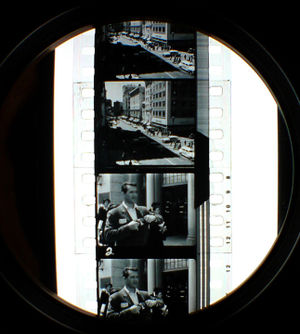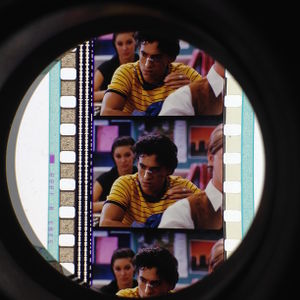| Welcome to Sprocket School! This project is maintained by volunteer editors. Learn more about how this works. |
Sound formats: Difference between revisions
Jump to navigation
Jump to search
No edit summary |
No edit summary |
||
| (5 intermediate revisions by 3 users not shown) | |||
| Line 4: | Line 4: | ||
'''Sound formats''' are technologies that allow recorded sound to be synchronized to (or otherwise accompany) a film. Sound formats also encompass more advanced technologies like '''noise reduction''' and '''sound processing'''. Before the advent of sound formats, all films were [[silent film|silent]]. | '''Sound formats''' are technologies that allow recorded sound to be synchronized to (or otherwise accompany) a film. Sound formats also encompass more advanced technologies like '''noise reduction''' and '''sound processing'''. Before the advent of sound formats, all films were [[silent film|silent]]. | ||
* [[magnetic sound]], [[optical soundtrack]], digital sound/sound on disc | |||
* magenta vs. cyan vs. black/silver/gray for optical tracks | * magenta vs. cyan vs. black/silver/gray for optical tracks | ||
* Determining sound formats (esp. optical formats) | * Determining sound formats (esp. optical formats) | ||
* Determining sound levels - best practices | * Determining sound levels - best practices | ||
* Amplifiers? | * Amplifiers? | ||
* Sound processors | * Sound processors | ||
| Line 28: | Line 27: | ||
| [[Dolby Digital]] || Digital || || x || || || || || Also called Dolby SR-D | | [[Dolby Digital]] || Digital || || x || || || || || Also called Dolby SR-D | ||
|- | |- | ||
| [[DTS]] || Digital || x || x || | | [[DTS]] || Digital || x || x || x || || || || | ||
|- | |- | ||
| [[SDDS]] || Digital || || x || || || || || | | [[SDDS]] || Digital || || x || || || || || | ||
| Line 41: | Line 40: | ||
[[Category:Film prints]] | [[Category:Film prints]] | ||
[[Category: | [[Category: Sound]] | ||
[[Category: Sound formats]] | |||
Latest revision as of 11:13, 26 May 2017


Sound formats are technologies that allow recorded sound to be synchronized to (or otherwise accompany) a film. Sound formats also encompass more advanced technologies like noise reduction and sound processing. Before the advent of sound formats, all films were silent.
- magnetic sound, optical soundtrack, digital sound/sound on disc
- magenta vs. cyan vs. black/silver/gray for optical tracks
- Determining sound formats (esp. optical formats)
- Determining sound levels - best practices
- Amplifiers?
- Sound processors
- Speakers
| Sound format | Type | 70mm? | 35mm? | 16mm? | 8mm? | Super8? | Other gauges? | Notes |
|---|---|---|---|---|---|---|---|---|
| Mono | Optical | x | x | variable density vs. variable area | ||||
| Stereo | Optical | x | ||||||
| Dolby SR (35mm) | Optical | x | ||||||
| Dolby A (35mm) | Optical | x | ||||||
| Dolby Digital | Digital | x | Also called Dolby SR-D | |||||
| DTS | Digital | x | x | x | ||||
| SDDS | Digital | x | ||||||
| Dolby SR (70mm) | Magnetic | x | ||||||
| Dolby A (70mm) | Magnetic | x | ||||||
| Magnetic | Magnetic | x | x | x | x | x |